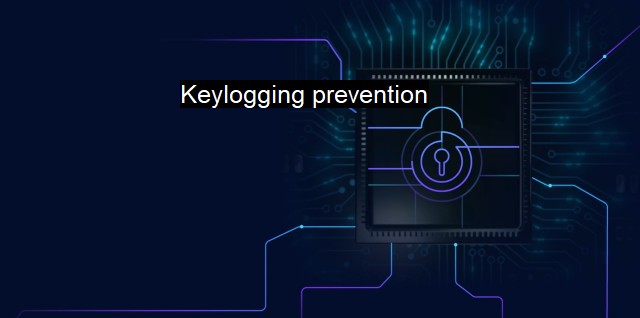What is Keylogging prevention?
Securing Your Keystrokes: Importance of Keylogging Prevention in Cybersecurity Measures
Keylogging or keystroke logging is a common form of cyberspace intrusion that involves the recording of individual keystrokes made by a user on a computer or device keyboard. Cybercriminals, for instance, can employ this sneaky tactic to compile sensitive information such as usernames and passwords, credit card details, or business secrets, often without the user's knowledge. Therefore, preventing keylogging, also referred to as anti-keylogging, is an imperative preventive cyber measure aimed at securing sensitive information from unauthorized access.Keylogging prevention represents a thorough set of strategies, tools, and concerted efforts designed to combat the numerous forms of keylogging, including hardware, wireless, kernel/ device driver keyloggers, API-based keyloggers, and memory-injecting keyloggers among others. By addressing these various forms of keyloggers, a comprehensive keylogging prevention strategy provides integral defense layers for data safety.
Anti-virus software is among the most common tools used in keylogging prevention. Up-to-date antivirus software across all devices, including stationary and mobile, is often the first line of defense and can identify and deal with malware, including keyloggers. Remember that constant updates are essential because keylogger methods constantly evolve, and antivirus providers update their databases as a response to these new threats.
Implementing a two-factor authentication process is another keylogging prevention method. Even if a keylogger acquires the initial password from a two-factor authentication, it generally will not be sufficient because the second layer of protective validation provides an extra barrier to protect sensitive data.
Automatic form fillers can help in preventing keyloggers. Many secure password managers comprise automatic form fill facilities that type essential details on behalf of the user, making it impossible for a keylogger to record keystrokes. Besides, password managers store all passwords securely and users only need to remember one master password, reducing the susceptibility to keylogging.
Another solution to prevent keylogging is security patches and updates. Software companies regularly post patches and updates to fix potential security loopholes, including those that cybercriminals could exploit via keylogging. Regularly updating both the operating system and applications will render keyloggers ineffective.
Firewalls also form a crucial aspect of the keylogging prevention framework. While firewalls may not directly prevent keyloggers, they can alert users when a software or application is attempting to transmit data over the internet, a signal of a potential keylogger. A strong firewall protocol and correctly configured rules aid in monitoring unusual outbound traffic and alerting the user in real time.
Anti-keylogging software is also available, designed to protect systems by detecting keyloggers based on their behavior rather than their signatures. This is vital as not all keyloggers can be identified through signature patterns, especially those deployed through Advanced Persistent Threat (APT) mechanisms.
Also, practicing conscious and mindful computing such as inspecting files before download, password hygiene including changing passwords routinely, and refraining from clicking on unverified email links all contribute to preventing keyloggers invasion.
Encryption at the keystroke level is another sophisticated method being employed for keylogging prevention. This involves encrypting keyboard-to-application communications, restricting an unauthorized external element's ability to interpret what a user is typing even if it gains access.
Keylogging prevention is essential in the trove of cyber security as anyone from individuals to corporations can be targets for keylogger-based cyber attacks. Consequently, it is paramount that users keep their systems and software updated, use advanced multitier authentication methods, employ solid antivirus software, and maintain good general internet hygiene in an ongoing effort to keep themselves safe from the threat of keyloggers. Regular cybersecurity education is also advisable, as understanding how keyloggers work and the variety of ways there are to counter these nefarious tools can also strengthen the fight against being compromised.

Keylogging prevention FAQs
What is keylogging prevention?
Keylogging prevention refers to the methods and techniques used to protect against keyloggers, which are malicious software programs that capture keystrokes made on a computer keyboard.Why is keylogging prevention important?
Keylogging is a common method used by cybercriminals to steal sensitive information such as usernames, passwords, and credit card numbers. Keylogging prevention helps to safeguard against these types of attacks and protect your personal or corporate data.What are some keylogging prevention techniques?
Some keylogging prevention techniques include using antivirus software, avoiding suspicious email attachments and links, keeping your software up-to-date, and using strong passwords. Another effective technique is to use a virtual keyboard, which allows you to input text by clicking on buttons on a screen rather than typing on a physical keyboard.Can antivirus software prevent all types of keylogging?
While antivirus software can provide protection against many types of keyloggers, it is not foolproof. Some keylogger programs are designed to evade detection by antivirus software or use complex techniques to capture keystrokes. Therefore, it is important to use a combination of prevention techniques to minimize your risk of keylogging.| | A | | | B | | | C | | | D | | | E | | | F | | | G | | | H | | | I | | | J | | | K | | | L | | | M | |
| | N | | | O | | | P | | | Q | | | R | | | S | | | T | | | U | | | V | | | W | | | X | | | Y | | | Z | |
| | 1 | | | 2 | | | 3 | | | 4 | | | 7 | | | 8 | | |||||||